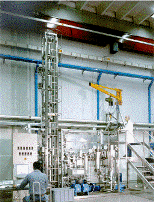For dense gas we means a fluid in supercritical state (SCF). It is a fluid (typically CO2 - carbon dioxide) with low molecular weight having a critical temperature close to ambient temperature (TC ~ 10 ÷ 40 º C) and a critical pressure is not too high (PC ~ 40 ÷ 60 bar).
The light hydrocarbons having these physical properties but have the problem and toxicity. Certain chlorofluorocarbons lend themselves to relatively expensive but are obtained at high purity and are now banned for environmental acceptability.
Carbon dioxide, although a slightly higher critical pressure (PC = 72.1 bar), offers other attractive properties that make it more fluid used in applications:
- environmental acceptability;
- nontoxic;
- low cost at high purities for the possibility of continuous recycling of gas;
The ability to modulate the density of SCF through modest changes in temperature and pressure, especially in the neighborhood of critical point (CP), is the distinguishing factor of these fluids. In this way we introduce as additional variable in the control of a process of separation and / or extraction pressure. Another important aspect for the quality of the final product is the ability to process the matrix in a gas saturated environment (typically CO2) inside extractor, pasteurizator, fractionation tower, micronization room, etc..) and thus obtain a product altered by oxidation.
At the present is our belief that the use of supercritical fluids has some interesting perspectives in industrial cases in which:
- the application of technology achieves more value due to the quality of the final product and complete environmental acceptability,
- the realization of scale economies in the scaling of industrial application makes comparable and competitive production cost with that of traditional technology,
- you are in the presence of thermolabile substances that are altered in traditional processes, resulting in loss of activity of the product.
The use of supercritical fluids (SCF) as solvents in separation techniques from the last decades has found wide application in the extraction (SFE Supercritical Fluid Extraction). It is currently also having significant developments in the processes of fractionation, "cold" pasteurization of liquid and in applications in the pharmaceutical field. After the first industrial applications of supercritical fluids (decaf, purification), the use of SCF is now applied in the pharmaceutical industry. A particular interest has arisen about the possibility of reducing the size of valuable and heat-sensitive substances, such as pharmaceuticals. Control over the size of the drug it would enable a specific use in administering to the patient. The conventional processes of size reduction have undoubted disadvantages:
- in milling, due to strong friction between the particles, the temperature undergoes localized elevations of the resulting degradation of the substance;
- crystallization occurs in the incorporation of the solvent and is always difficult to control the size of the precipitate.

Extraction from herbaceous matrices
- Supercritical fluid extraction (SFE) of essential oils, resin oils, dyes, active principles from vegetable matrices (roots, leaves, rhizomas, flowers); fields of interest: food, cosmetic, pharmaceutical industry
- Extraction of biologically active molecules from solid natural stuff, as medicinal plants; particular interest is addressed to chlorinated and organic solvents substitution
- Extraction and fractionation of active molecules from diluted media, as fermentation broth, or from natural and synthetic liquid sources
- Production of enriched fractions
- Dewaxing of natural products
Fractionation of liquid feeds
- Husk oil, refined oil, and rape oil treatment for acidity and sterolic content reduction, pigments (charotenoids, chlorofill) and waxes removal
- Recovery of tocopherols from deodorizer condensates oils
Purification of synthetic-end products
- Organic solvent removal from pharmaceuticals (dichloromethane, isobuthyl alcohol)
- Substitution of chlorinated solvents in cosmetics industry
Impregnation
- Inpregnation of synthetic or natural polymer matrices for preparing highly disperded catalysts, controlled drug delivery systems or to improve the matrix properties tablet coating, to avoid the use of organic solvents
Powder technology
- Crystallization and atomization through the rapid expansion of a supercritical solution (RESS, rapid expansion of supercritical solution): application to antibiothic (salicylic acid), antimicotics (griseofulvin), hormones (progesteron, testosteron)
- Precipitation induced by SC antisolvent effect (SAS, supercritical antisolvent precipitation) starting from homogeneous solutions: batch and continuous process; application to biopolymers and drugs (ialuronic acid, pentamidine, salbuthanol)
- Encapsulation of pharmaceuticals with biocompatible polymers (ethylcellulose, acrylic polymers) via SAS technique starting from heterogeneous solutions: batch process
Reactions
- Reaction and fractionation combination with possibility of organic solvent substitution, easy downward processing permitting reactants recycle and high reaction rates in relation with high diffusivity in the supercritical (SC) solvent

